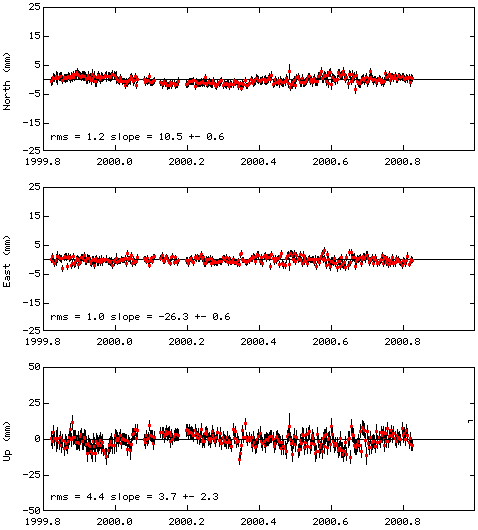What is SCIGN?
SOPAC#2
What information is gathered?
SOPAC#3
What organizations benefit from this information?
SOPAC#4
About how many sites are in the SCIGN array?
SOPAC#5
How is a site constructed?
SOPAC#6
What is plate
tectonics?
SOPAC#7
What is the GPS?
Next review the activity, How Fast Is The Jet Propulsion Laboratory's Station Moving? Use the results here to repeat the exercise for College of the Desert, as described below:
Concepts:
The crust in Southern California is constantly moving
and deforming. GPS receivers in the SCIGN network can measure these movements,
even when they are very small. By collecting data over time, the movement
of GPS receivers can be calculated. These movements are plotted on
a graph, called a time series. The slope of the line connecting the data
points represents the site's velocity. Print out of the time series
for the GPS station located at College of the Desert (cotd). This
plot can be obtained via the SCIGN Analysis Homepage, located at http://milhouse.jpl.nasa.gov/scign.
Go to the map at the bottom of the page and click on the cotd dot which
you'll find all the way to the east at about the middle. Click on
the Time Series
link and you should find a graph similar to the one below. Note that
there is much less data than at some of the older stations such as the
one at JPL.

At the Locate
GPS Site enter "cotd" in the dialog box and press "submit." In
the page there follow the link
and you can data to make plots like the one shown here. Things have changed at this
site and I haven't kept up with all the changes, so...have at it anyway!

Background
The Southern California Integrated GPS Network (SCIGN)
is a series of GPS receivers that
continuously record information transmitted via radio
waves by 24 satellites orbiting the earth. This information is collected
and processed by scientists at JPL in order to determine the receivers'
positions every day. This data is then plotted on a graph called a time
series, which shows an individual receiver's position (y-axis) over time
(x-axis.) By fitting a line to the data points and calculating the slope
of the line, the velocity (a change in distance over a change in time)
of a station can be determined. The time series supplies the calculated
velocity for each of the position coordinates (latitude, longitude, height,)
including error. If the slope were not supplied, it could still be determine
by taking the rise (movement in one direction) over the run (time.) The
time series also gives the station name, and the repeatability, the average
change in the position over the total time.
Scientists can use this information to determine how a
station is moving and simultaneously deduce what deformation is occurring
in the Southern California crust. This is helpful in pinpointing
areas that are deforming (straining) faster, which may mean an increased
seismic risk. Hopefully, in the near future, the models made from the data
collected by the SCIGN network will assist in determining aftershock risk
areas following major earthquakes; lead to preventative measures limiting
the destruction of buildings and property and advance the understanding
of the earthquake process in Southern California.
Answer the following questions based on the College of the Desert station:
SOPAC#8
What is the latitude rate?
SOPAC#9
What direction is that?
SOPAC#10
What is the longitude rate?
SOPAC#11
What direction is that?
SOPAC#12
What is the vertical rate?
SOPAC#13
What direction is that?
SOPAC#14
How long has this station been recording data (according
to the plot)?
SOPAC#15
What can you say in general about this station?
SOPAC#16
Using the rate values found in questions 2 and 4, for
the latitude and longitude, and the Pythagorean theorem, solve for the
overall horizontal velocity of the station (the hypotenuse.)
SOPAC#17
Now try the same calculation on another station of your
choice (see URL in Materials section for additional time series.)